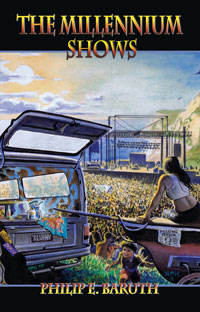Summary

Philip E. Baruth’s 1994 novel The Millennium Shows is perhaps the best of the Grateful Dead-related novels. The Dead connection aside, it is also simply a wonderful, insightful novel, one that stands on its own as a fantastic piece of writing. Moreover, The Millennium Shows has an interesting history. Snippets of it were published in the Denver Quarterly in 1990 as “I Am These Dead.” The short story version was nominated for the prestigious Pushcart Prize in 1991. Eventually, the novel arrived in 1994. Originally published by Albion Books, over the years the status of the novel has grown within the Deadhead community. Indeed, Mr. Baruth came under a certain amount of criticism for “predicting the death Jerry Garcia” a year before it actually occurred. He remains philosophical about this accusation and addressed it in a 1999 essay entitled “Precisely How and Why I didn’t Kill Jerry: Ethnography, Surrealism and The Millennium Shows” published in the edited volume Perspectives on the Grateful Dead: Critical Writings. In the essay Baruth explains his rationale for writing the novel and the subsequent reaction to it.
Most importantly, The Millennium Shows is a penetrating and prescient interpretation of the sociological implications of the early 90’s Deadhead scene. Yet to say The Millennium Shows is a landmark of Grateful Dead fiction is to sell it short, as it is also a landmark of American fiction—a prophetic page-turner that is mysterious, visionary, horrifying, and compulsively readable. It is a tale of displacement, angst, love, and the struggle of a regular guy to maintain his autonomy in the face of an intrusive and increasingly hive-like society. Indeed, Baruth burrows deep into the darker side of Deadhead culture. With his mysterious and conflicted narrator, Story, we move through the underworld of traveling families bound together—and wrenched apart—by the encroaching pressures of surviving outside mainstream America. But there is more than Deadhead culture here. There is a Burroughsian insect awareness of claustrophobic catacomb energies that will reach deep inside of you and shift your perception in almost chemical ways. Joan Didion, in “Slouching Toward Bethlehem,” a highly critical essay on the young hippies of San Francisco’s Haight Ashbury, made this observation: “We were seeing something important. We were seeing the desperate attempt of a handful of pathetically ill-equipped children to create a community in a social vacuum.” Likewise, we see this attempt fully extrapolated a generation later in The Millennium Shows. Yet, unlike Didion, Baruth’s portrayal is not an outsider’s. His viewpoint character, named Story, who at one point tells us that “There was never a day in the history of the world when there was less resistance to passing into a group,” takes the reader inside the caravanning Deadhead scene. “Most mornings we rippled into consciousness,” Story says, always viewing his world with languid vividness. It isn’t until well into this finely nuanced novel that our protagonist’s steady, omniscient tone begins unraveling into psychic dissonance.
